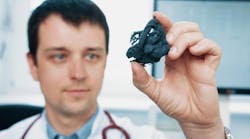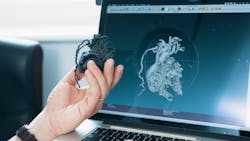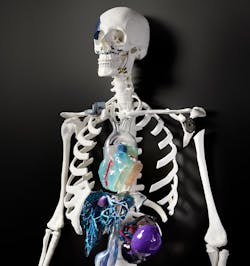There is never a dull moment in 3D printing. From printing organs to helping prepare doctors for surgeries to trying to print fully formed organs, 3D printing may well enable a leap forward in human life expectancy. This article will recap some of what 3D printing has already done, and the new technology that is one step closer to making healthcare better.
Recently, Sinterit launches a soft thermoplastic polyurethane (TPU) to be used in small selective laser sintering (SLS) 3D printers. At Formnext 2018, the company will show off its soft TPU powder intended for small SLS 3D printers, called Flexa Soft. With a hardness between 40-55 in Shore A type scale, the company thinks this material will help doctors perform mock surgeries.
Some materials are too hard to cut. When doctors are printing organs to prepare for surgery, they are often just a tangible reference. Extrude plastic printers are common, cost-effective, and accessible for most anyone. Unfortunately, an extruded plastic method might not provide material that is easy to cut. However, Sinterit claims this new soft SLS powder is more realistic feeling and cutting. Stratasys also has a BioMimics to print a replica or accurate, functional models for students and doctors to use with training. With a multi-jet process, users can control the durometer and color of the material to print sections of the body with more accurate soft, hard, or colored areas.
Despite this, I’ve only heard from one doctor who’s tried performing surgery on a printed organ, and he described it as lacking. While not knocking the benefits 3D printing is bringing to the medical industry, the doctor says without some type of fiber in the material, it just won’t feel the same as cutting human tissue, muscle, and organs. However, this has not slowed 3D printing in the medical industry.
Cardiologists Use 3D Printing to Save Tiny Lives
Sinterit also published the case of a pediatric cardiac surgery performed on Kordian, a three-week-old infant boy in Poland. It is unclear whether a soft or hard material was used in this case, but today the baby is 18 months old and reportedly doing well. And the doctors say the 3D-printed model did help.
Most doctors can get an idea of what they are up against based on their experience or the popular methods like CT scan and MRI. The real challenge starts when the part is tiny, the disease is rare, or the case is otherwise atypical. In all of those examples, even sub-millimeters can make a life-or-death difference. To increase Kordian’s chance of survival, surgeons decided to 3D print his heart with a laser sintering desktop 3D printer.
Kordian was suffering from the heart disease called interrupted aortic arch. “The problem was that aorta, the biggest vessel that is coming out of the heart was suddenly interrupted,” says Jarosław Meyer-Szary, M.D. from the Department of Pediatric Cardiology and Congenital Heart Defects, University Clinical Center in Gdańsk, Poland.
SLS 3D Printing Offers a Hand
An interrupted aortic arch during surgery could be fatal. Jarosław Meyer-Szary, M.D. from the Department of Pediatric Cardiology and Congenital Heart Defecs, University Clinical Center in Gdańsk, Poland. made the decision to use a life-sized 3D-printed model of Kordian’s heart to study before the surgery. Plastic extrusion processes are normally good for printing parts and organs to show doctors anomalies up close and make a tangible model for the doctor. Unfortunately, for this case this technology wouldn’t work. Doctors had to imitate every little vein and artery that surrounds the heart. Plastic extrusion veins were either too thin to print or, because of the needed supports, could be easily torn apart during post-processing.
SLS technology met the requirements. Such SLS 3D-printed models can be used both for planning the cardiac surgery and interventional procedures, especially in complex and rare congenital heart diseases when the anatomy always varies from patient to patient. It is thus important for the patients—and in this case, parents—to understand the situation and give the permission to operate.
“As a head of a department I have to talk to parents, students and explain sometimes very complicated congenital heart defects to the people who are not doctors, not professionals in this area,” says Joanna Kwiatkowska M.D., Ph.D., from the University Clinical Center.
3D Printing Makes Surgery Safer, Easier, and Shorter
3D-printed medical models help to increase surgeon confidence in planning procedures and assist in the training of medical students. These tangible reproductions of a patient’s specific anatomy result in more accurate, hands-on planning, and enable safer procedures for patients with the potential for smaller incisions, less radiation, and/or less anesthetic.
Research published in The Cleft Palate-Craniofacial Journal has shown this technology can help hospitals save up to 31 minutes in the operating room per case, resulting in cost savings of $1,036 per operation. Implementing 3D printing operations as an in-house service in a hospital can also allow for greater automation, faster turnaround times, and more opportunity for collaboration and iterative work on complex cases.
“This was a difficult surgery, and such a model helped to see the heart more close then on the TV screen,” says Meyer-Szary of Kordian’s case. Today, the boy’s happy face and positive attitude toward new people belie the fact that just over a year ago, his life was in jeopardy.
3D printing can generate implants. This means the implant is generated from the patient’s CT or MRI scan that will provide a custom fit. This eliminates hours of hand-made customization with traditional processes that wouldn’t provide a fit as well as the 3D-printed implant.
Types of Models and the Future of 3D printing
In the U.S. Drs. Bon Ku and Rob Pugliese of Thomas Jefferson University and Hospital in Philadelphia created a new laboratory with Ultimaker 3D printers, a plastic extrusion printer, for doctors to better hone their skills to perform better under pressure. This program also let students and doctors design tools for their own solutions.
While printing tools, organs, and implants to help with surgeries, 3D bioprinting is speeding up drug screenings. Current 3D bioprinting approaches have demonstrated that 3D-printed tissues can be used as disease models for predictive drug screening. There has been an explosion in interest for 3D-printed human tissues; its global market size was estimated at $295 million in 2016, and is expected to grow to $1.8 billion by 2021. These values are based on the applications of 3D-printed tissues, which include disease tissue modeling, toxicology testing, tissue engineering, and skin transplants.
For example, tumor cells extracted from biopsy samples can be printed and matured in the laboratory to create patient-specific tumor replicas, which can then be used to screen combinations of therapeutic drugs to create individualized cancer treatments. Although there are still several technical challenges, there is a bright future ahead for 3D bioprinting technology.
While 3D bioprinting is speeding up drug screenings to get through the FDA, it might be more difficult for other technologies to pass regulations. There are researchers that are trying to print parts, or entire organs. A Machine Design article by Joyce Laird discusses an instrument built by Tissue Genesis Corp. that allows you to put fat into the device; it sorts out the viable cells so they are ready to be implanted back into a patient, or else used to 3D print new hybrid organs and body parts.
Researchers at the University of Louisville are already printing layer-by-layer cellular structures, but without a vascular supply, once the organ thickness gets beyond half a millimeter, there is a loss of oxygen or nutrients to the center of that material. This is stated in multiple 3D bioprinting research papers. However, The University of Louisville is currently developing structures that are pre-vascularized to keep these cells alive.
The researchers have developed a way to 3D print capillaries, the smallest blood vessels. By doing so, they are able to make very viable structures, particularly the ventricular walls of the heart, with the vascular supply built into it. One researcher, Stuart Williams, boldly said that he believes they are farther ahead of any other group.
“We are at the stage of doing implantation of pre-clinical models and are currently planning human clinical trials of pre-vascularized structures for a patch for the human heart,” Williams says. “We are not that far away. This would be used on a part of the heart that had very poor or damaged vascular flow for whatever reason, where a bypass graft or a stent will not solve the problem.
“You have to get to the level of the smallest blood vessels,” he continues. “Using bioprinting to do this is still several years in the future.”



